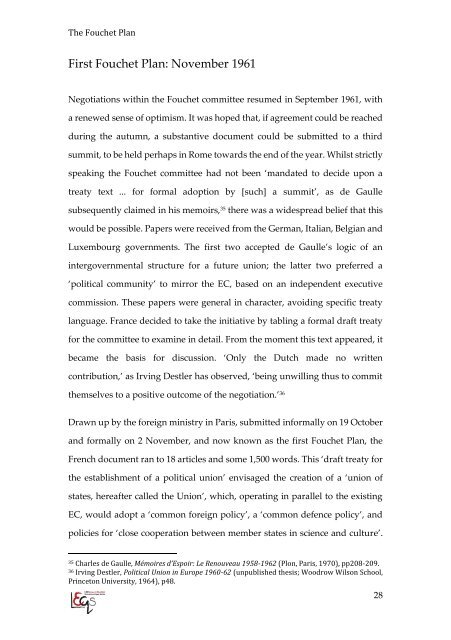The Fouchet Plan De Gaulle’s Intergovernmental Design for Europe
n?u=RePEc:eiq:eileqs:117&r=cdm
n?u=RePEc:eiq:eileqs:117&r=cdm
Create successful ePaper yourself
Turn your PDF publications into a flip-book with our unique Google optimized e-Paper software.
<strong>The</strong> <strong>Fouchet</strong> <strong>Plan</strong><br />
First <strong>Fouchet</strong> <strong>Plan</strong>: November 1961<br />
Negotiations within the <strong>Fouchet</strong> committee resumed in September 1961, with<br />
a renewed sense of optimism. It was hoped that, if agreement could be reached<br />
during the autumn, a substantive document could be submitted to a third<br />
summit, to be held perhaps in Rome towards the end of the year. Whilst strictly<br />
speaking the <strong>Fouchet</strong> committee had not been ‘mandated to decide upon a<br />
treaty text ... <strong>for</strong> <strong>for</strong>mal adoption by [such] a summit’, as de Gaulle<br />
subsequently claimed in his memoirs, 35 there was a widespread belief that this<br />
would be possible. Papers were received from the German, Italian, Belgian and<br />
Luxembourg governments. <strong>The</strong> first two accepted de <strong>Gaulle’s</strong> logic of an<br />
intergovernmental structure <strong>for</strong> a future union; the latter two preferred a<br />
‘political community’ to mirror the EC, based on an independent executive<br />
commission. <strong>The</strong>se papers were general in character, avoiding specific treaty<br />
language. France decided to take the initiative by tabling a <strong>for</strong>mal draft treaty<br />
<strong>for</strong> the committee to examine in detail. From the moment this text appeared, it<br />
became the basis <strong>for</strong> discussion. ‘Only the Dutch made no written<br />
contribution,’ as Irving <strong>De</strong>stler has observed, ‘being unwilling thus to commit<br />
themselves to a positive outcome of the negotiation.’ 36<br />
Drawn up by the <strong>for</strong>eign ministry in Paris, submitted in<strong>for</strong>mally on 19 October<br />
and <strong>for</strong>mally on 2 November, and now known as the first <strong>Fouchet</strong> <strong>Plan</strong>, the<br />
French document ran to 18 articles and some 1,500 words. This ‘draft treaty <strong>for</strong><br />
the establishment of a political union’ envisaged the creation of a ‘union of<br />
states, hereafter called the Union’, which, operating in parallel to the existing<br />
EC, would adopt a ‘common <strong>for</strong>eign policy’, a ‘common defence policy’, and<br />
policies <strong>for</strong> ‘close cooperation between member states in science and culture’.<br />
35 Charles de Gaulle, Mémoires d’Espoir: Le Renouveau 1958-1962 (Plon, Paris, 1970), pp208-209.<br />
36 Irving <strong>De</strong>stler, Political Union in <strong>Europe</strong> 1960-62 (unpublished thesis; Woodrow Wilson School,<br />
Princeton University, 1964), p48.<br />
28


